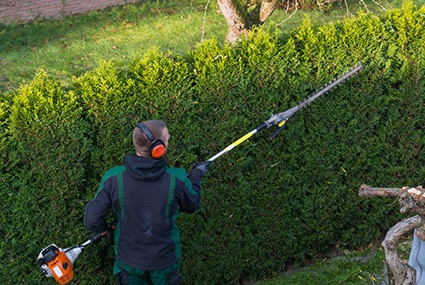For the first couple of years, a new hedge should be pruned either in the winter or spring. These first trimmings are called formative pruning. From then on maintenance pruning should be done between spring and summer. Informal hedges need this once a year, whereas formal hedges require twice a year and occasionally a third pruning in order to keep a tidy appearance.
Pruning tips for shrubbery and hedges
Manual shears should be used for smaller plants, and for larger plants an electric or gas trimmer is required. No matter the choice in the tool, make sure it is well lubricated and sharp. When wielding a power tool, think safety first. This means sturdy gloves and safety glasses. Make sure the ground is clear of any obstacles in your work area and that if using a platform or ladder, they are completely stable.
When using corded power trimmers, to prevent the cord from being sliced, place it over your shoulder. Avoid using any power tools in damp or wet conditions. Using a hedge trimmer that has an extended reach and features a cutting head that pivots will simplify your job, especially when pruning those hard to reach areas.
Take out the thickest branches of overgrown shrubs. Cut them back completely to the shrub’s base to encourage the growth of the shrub. Long-handled Loppers will give you the leverage to prune one to two-inch branches, use hand pruners for the branches smaller than one inch.
When cutting a branch, make sure the wood is deep into the cutter’s jaws. This will give you better leverage to make the cut and make it a cleaner cut which will enable faster healing. If you live where snow is common, you might consider cutting a rounded top into your shrubs and hedges to prevent snow accumulation.

Be aware of the following:
- Before beginning work on your plants, check for birds nesting as it is an offence to damage or destroy any wild birds nests in use or being built.
- Do not trim conifer hedges after August; however, yew can be safely pruned all the way till September.
- Boundary hedges should be kept trimmed in order not to impede access to pedestrians via overhang of the street or walkways. Even hedges that are regularly pruned can become quite large.
- Broadleafed and deciduous evergreens can often be radically cut back and their growth corrected, however, some old conifers and plants that can’t be cut back, should be replaced so as not to be a nuisance.
- Hedges can be formal or informal, informal hedges can be anywhere, even used as a windbreak at the edge of a land boundary. Formal hedges are beautiful in English gardens, skirting manor houses, and setting off special landscaping features such as fountains and statues.
- Roses can be used as formal shrubbery to set off resting areas on large formal grounds. For the creative types, growing shrubbery into shapes such as animals can be quite striking and eye-catching. Just remember to keep them pruned to stay looking their best.


